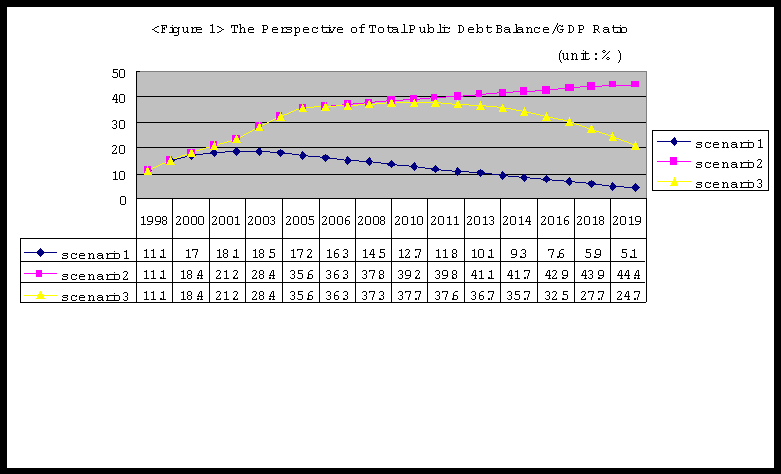
The National Debt Issue in Fiscal Exchange in Korea
- The Measurement of the Net Fiscal Burden by Income Classes -
Pil-Woo Rhee
Dpt. of Economics
Konkuk University
93-1 Mojin Dong, Kwangjin Ku,
Seoul Korea
Tel : 02-450-3617
Fax : 02-3436-6610
E-mail : kkuiem@kkucc. konkuk. ac. kr.
Contents
I. Introduction
II. Methodology
1) Analytical Approach
2) Method of Measurement
3) Three Scenarios
III. Debt Management Policy
IV. Evaluation of the Value of Fiscal Exchange corresponding to National Debt
V . Net Fiscal Burden of National Debt
IV. Conclusion
I. Introduction
This paper attempts to evaluate the value of fiscal exchange between tax payers and fiscal authority with regard to the national debt issue since the financial crisis of Dec. 1997 in Korea. As we are well aware, under the current financial crisis the Korean economy has been facing tremendous difficulties such as the increasing unemployment and a large number of bankruptcies. Under this situation, the Korean government policy has concentrated on the structural adjustment of overall economic sectors in general, specifically in the capital market.
The large amount of non-performing loans (NPL) by enterprises will be absorbed and managed by the Korea Asset Management Corporation, which badly needs funds for its management. These funds are financed by state guaranteed debt (SGD). Now, the interest of this company debt has to be financed by fiscal support, which increases the budget size in 1998 and 1999. Additionally, in this context, we should pay attention to the unemployment problem, which is likely to generate social unstability. Increasing unemployment may be considered as a negative externality of the monetary crisis in Korea. The Korean government, therefore, decided to render fiscal subsidies to the unemployed (prior to 1998, there was no unemployment insurance system in Korea), which will eventually increase the budget size as well. The issuance of national debt in Korea is brought about by the above two reasons.
Though the deficit finance is for the first time launched since the Korean War, there seems to be little interest paid to it. In this respect, the Korean government used to say that its GDP ratio is still much lower than the advanced countries and to emphasize only the effort to restraining expenditures as a debt management policy. Less attention has been paid to how to provide services for the debt finance and how much our new generation would bear. Furthermore, the main interest of this paper is to inquire how much benefit would taxpayers get and bear fiscal burden by the issuance of national debt, which is closely related to the fiscal exchange.
The main purpose of this study is to offer some information on these neglected interests. That is to examine the magnitude of fiscal exchange between taxpayers and fiscal authority with regard to the national debt issuance, whose thesis is fundamentally postulated by K. Wicksell and J. M. Buchanan.
II. Methodology
1. Analytical Approach: Money Terms Approach
Methodologically, this paper heavily relies on the thesis that is the well-known principle of equality between value (Listing) and counter value (Gegenleistung) according to K. Wicksell. The thesis implies that the benefits arising from public expenditure should be in its value equal to the value of taxation as the price of public goods paid by tax payers1 (K. Wicksell). It is concerned with fiscal exchange in terms of modern fiscal theory, urged by J.M. Buchanan2.
This thesis basically goes back to Wicksell
’s fiscal paradigm that a true democracy could be realized only on the condition that tax and expenditure in value is equalized. We assume methodologically as follows: First, the subjective utility of public goods is constant for respective individual. So, generally, the expenditure financed by national debt is conceived, except for its interest payment and subsidies to unemployed, as not excludable to all taxpayers to consume.The spending effect of national debt is apparently referred to non-exclusion principle due to the pure nature of public goods except for interest and subsidies.
Second, the preferences of taxpayers are assumed to be also constant. Especially under the financial crisis prevailing currently in Korea, the Korean taxpayers are mostly well aware what should be performed by the government. As a whole, this study is based on the thesis that the classical principle of equality between the price of public goods (tax) and the utility of public goods (benefit) should be kept as a basic fiscal norm and philosophy, as E. Sax, J. Mazzola and K. Wicksell argued. It is related to taxation based on benefits, not on the ability to pay, from the efficiency point of view.
However, it must be noticed at the outstanding that the value of tax or expenditure is in this study taken for granted as measured in monetary unit, Won, that is the amount of tax paid by people, and the amount of expenditure spent by fiscal authority, but not in terms of the quality of tax and expenditure payment. The value of tax and expenditure, therefore, is thought of in terms of quantity but not in quality. This might be severely criticized from the view point of qualitative aspects of fiscal operation. One might consider the value of expenditure in terms of productivity or efficiency depending on either attitude of bureaucrats or method of budget execution. On the other hand, the value of tax could be thought of opportunity cost which otherwise the private would realize the maximization of self interest. In this context, we are well aware of A. C. Pigou
’s theorem on optimal budget model, referring to which the marginal cost of tax should be equal to the marginal benefit of expenditure by government.However, in spite of its normative justification, in reality, it is hard to compare the marginal value of two accounts due to the formidable difficulties in its measurement. That is the reason why we eventually come to choose the quantity approach in which the value, tax and the counter value, benefit of expenditure, are measured in sum of tax revenue and expenditure in monetary terms. Furthermore, we do not consider the discount factor for capitalization in measuring fiscal benefits and burdens. The reason for it is that as J.M. Buchanan asserts, in case of public debt, the value of fiscal benefits and burden would be perverted and perceived less than the value in reality, if present value method is applied. 3 We try to illustrate it just with a simple numerical example.
2. The Method of Measurement
1) The Definition of Fiscal Benefits from National Debt
By fiscal benefits in this study, we confine to mean the benefits for tax payers accruing from expenditures spent by national debt. For simplicity of its measurement, the benefits are calculated in a sum of the national debt spending in money terms. So it goes without taking into consideration of the macroeconomic effects in the long run, as far as the effects of expenditure are concerned. This study concerns several kinds of benefit in measurement.
Absolute amount of national debt spending (NDs) is equivalent to nominal benefit (Bn). The national debt spending (NDs) is composed of the national debt spent for the deficit budget (NDd), the conversion debt for refunding (NDc) and the national debt spent for interest (NDi).
NDs = NDd + NDc + NDi
Bn = NDd + NDc + NDi
There are real benefits from national debt spending (Br). We take for granted to mean those benefits received by taxpayers in money terms. Those (Br) are composed of the subsidies to the unemployed (Br1), and the national debt spent for the interest payment to financial restructuring bond (Br2). So the total real benefits from the national debt spending is as follows:
Br = Br1 + Br2
Then, Br is generated by the national debt spent for deficit budget, neither by NDc nor by NDi. It is clear that the size of Br is less than Bn.
Br < Bn
Br = NDd
NDd = Br₁ + Br₂
The value of Br is obtained by subtracting NDc and NDi from Bn.
Br = Bn - NDc - NDi
Regarding public debt theory (J. M. Buchanan), the interest payment of debt is born by the present taxpayers. However, this is not applicable to the case of Korea, for the fiscal authority intends to issue another ND for financing the interest payment of debt that would impose no burden on the present tax payers. Thus the ND in size is increased by the amount of interest payment, which leads most probably to the increase in the burden of future generations.
(1) Benefit from the Fiscal Support for Financial Restructuring
It is generally well recognized that in Korea the ND had to be issued for fiscal support by undertaking the interest payment to be paid for the financial restructuring fund by government owned corporation. In this case, it should be kept in mind that theoretically the interest payment is treated as a burden of taxpayers, but the fiscal authority is obligated to support the financial restructuring. At least the interest payment for the debt of fund to absorb the non-payable loan in financial sector ought to be supported by fiscal sector. This amount of interest payment is fiscally financed by the ND issuance. The interest payment financed by ND is conceived as a necessary fiscal cost that helps to rehabilitate financial order. Therefore, taxpayers are supposed to receive benefit in various forms and these benefits are not excludable from consumption, or utilization of the merit of rehabilitated financial order. The utility of this order to taxpayers is apparently variable with individual capability to utilize its merit, as E. Sax already mentioned (R. Musgrave, and A. Peacock. 1967. P. 104). Therefore, in this analysis, Br2 is measured by income classes with different income distribution, which is in this analysis considered to be a criteria for individual capability to utilize the merit of rehabilitated financial order.
The proportions of fiscal benefit by five income classes are as follows. For the simplicity and convenience in measurement, we take only five income classes instead of 10 income classes.
<Table 1> Proportions of Fiscal Benefit in Case of Financial Restructuring
(Unit: %)
| Quintiles | 1999 - 2002 | 2003 - 2020 |
| 1st | 7.4 | 8.3 |
| 2nd | 12.8 | 13.4 |
| 3rd | 17.1 | 17.5 |
| 4th | 22.9 | 22.9 |
| 5th | 39.8 | 37.8 |
(2) Benefit from the Fiscal Subsidy to Unemployed.
It is also acknowledged that ND is issued to finance the subsidies (Br1) to be paid to unemployed workers who lost their jobs due to the restructuring policy. The number of unemployed in May 1999 is almost 1.7 million with unemployment rate 8.5%. The benefit from the subsidy to unemployed is calculated with some weights given to the five income classes. Most unemployed workers belong to the low-income classes ranging from 1st to 3rd income class. Fiscal benefit ratios based on weights applied to income classes are as follows:
<Table 2> Proportions of Fiscal Benefit in Case of Fiscal Subsidies to the Unemployed
(Unit : %)
|
Income |
Fiscal Benefit (based on weights) |
|
1st |
40 |
|
2nd |
25 |
|
3rd |
20 |
|
4th |
10 |
|
5th |
5 |
2) Defining the Fiscal Burden due to National Debt
The fiscal burden due to ND issuance occurs due to those taxes imposed on tax payers by tax authority in order to refund the principal of ND as well as the interest payment of ND. The interest payment is undertaken by both present and future generations. However, the payment for principal will be born by future generations. The fiscal burden of debt as a whole (T) is composed of interest (I) as well as principal payment (P). It can be written as following:
T = I + P
I = i (Bn)
In this context, it should be noticed that the fiscal burden of ND has to be distributed in accordance with the tax burden ratio out of total tax revenue by different income classes. For the exact measurement of fiscal burden we employ the tax burden ratios by five income classes in 1998. So total fiscal burden has to be dispersed to five income classes according to tax burden ratios respectively. The tax burden ratios owing to ND by five income classes are as follows:
<Table 3> Proportions of Fiscal Burden by Income Classes
(Unit : %)
|
Income Class |
Fiscal Burden Ratios |
|
|
1992 - 2002 |
2003 – 2020 |
|
|
1st |
3.3 |
3.3 |
|
2nd |
7.0 |
7.5 |
|
3rd |
11.9 |
11.2 |
|
4th |
22.7 |
21.0 |
|
5th |
55.1 |
57.0 |
3) Definition of Net Fiscal Burden of Taxpayers by ND: Value of Fiscal Exchange
In this study, it is considered that a net fiscal burden (b) is equivalent to a trade off value between real fiscal benefit (Br) and fiscal burden (T), that is, deducting the fiscal burden from the real benefit. If the number of value is positive, tax payers would have benefits, and if negative, they bear more burden than their benefit from it. Therefore, the balance of fiscal exchange is achieved between government supplying public goods to tax payers and tax payers paying price of public goods. So net fiscal burden (b) can be obtained by deducting fiscal burden (T) from absolute real benefit (Br).
If the value of fiscal exchange is bigger than zero, b = Br - T > 0, tax payers are seemingly benefited, but they are fiscally illusioned by the fiscal authority. If the value of fiscal exchange is zero, then the fairness in fiscal exchange is realized. However, if b = Br -T < 0, tax payer is damaged by exploitation of fiscal authority. This fiscal thesis is formally stated by Nobel Laureate J. Buchanan. This study actually aims to show the value of fiscal exchange, specifically in the case of national debt issue in Korea.
In case of debt finance, the fiscal burden appears in later periods of debt service by future generations. Of course, it is clear in the case of ND in Korea, that the fiscal exchange in value is negative for future generation, because they have to bear extra taxation for refunding the debt, while the present generation enjoys the benefit by receiving the unemployment subsidies. So the value of fiscal exchange would be positive for the present generation. It would work in favor of people supporting the current political regime.
3) Three Scenarios
We would predict some specific features with regard to the net fiscal burden in future period from now to the year of 2030 by applying three scenarios. These three scenarios have different assumptions respectively, which are relevant to the possible circumstances in fiscal affairs in Korea.
There are three aspects that are relevant to debt management in Korea. The first is concerned with the expenditure retraining policy that the fiscal authority intends to achieve. In order to serve the debt, the government should behave in expenditure policy very prudentially and in an effort to restrain spending in current expenditure so as to generate the budget surplus that will have to refund the national debt. If the Korea Asset Management Corporation would fail to sell its bonds successfully, or if the size of non-performing loans (NPL) would unexpectedly expands, not only must the additional national debt be eventually issued but also the government guaranteed public debt will have to be issued more.
The third aspect concerns the increase in government fiscal revenue including taxation. This factor is considered as the most strategic source for the refunding of the national debt, which however, would inevitably give a heavy burden on people or common taxpayers.
The scenario 1 is concerned with the first aspect, which is accepted by the fiscal authority as debt management policy. If this policy is concentrating on the expenditure restraining policy with 2% less than GDP growth rate each year, the large amount of the national debt will be served, even without any additional fiscal burden on the people. We call this kind of scenario as the optimistic debt management policy.
The scenario 2 refers to the worst fiscal situation, in which both the expenditure restraining policy and the government public debt management fail and the increase in government revenue fails as well. This would be called the pessimistic fiscal situation in debt management.
The scenario 3 is related to the third case of fiscal affairs that is successful in increase in the fiscal revenue. But it should be made clear that this success would be available under the situation with the prudent budget operation especially in expenditure policy and with failure in the financial restructuring management.
These three types of scenario would be notified as shown in Table 4.
<Table 4> Three Types of Scenario
|
|
Expenditure Restraining |
Gov. Guaranteed -Debt Management |
Gov. Revenue Increase |
|
Optimistic Situation (Scenario 1) |
Success |
Success |
Neutral |
|
Pessimistic Situation (Scenario 2) |
Failure |
Failure |
Failure |
|
Fiscally PrudentSituation (Scenarion 3) |
Neutral |
Failure |
Success |
III. Debt Management Policy
The fiscal authority has shown a plan of the debt management included in the mid-term fiscal plan (1999-2002). According to the plan, due to the shortage of fiscal revenue the national debt will have to be issued until the year of 2002 to cover a adequate budget size. In 2005, however, the budget is planned to be balanced. Then, from 2006 on, the national debt will be served by the possible budget surplus. This fiscal surplus will be generated as the fiscal authority tries to intend, mainly by a crucial effort to save and restrain the current expenditures. This plan is actually designed to increase annually the expenditure with 2% less than the current rate of GDP increase. It seems to be fairly impressive that the Korean government would expect that the national debt will be ceased to issue in the year 2006, and its service will be completed by the year 2016.
One of the IMF advises for rehabilitation of the Korean economic order as a whole has been a fiscal support for financial restructuring, which refers to the payment of interest on the debt fund for absorbing the unpayable loan. <Table 5> shows the amount of national debt issuance in respective year from 1998 to 2000 included in the midterm fiscal planning.
<Table 5> National Debt Issue including Interest (1998 - 2002)
(Unit: Trill. Won)
| 1998 | 1999 | 2000 | 2001 | 2002 | |
| ND Issue | 11.7 | 13.8 | 13.5 | 11.7 | 7.3 |
| Interest on ND | 0.2 | 1.9 | 2.0 | 2.7 | 3.4 |
| ND spent for Financial Restructuring (interest for Bond) | 3.6 | 7.8 | 7.7 | 6.9 | 6.9 |
| ND spent for Subsidies to Unemployed | 7.9 | 4.1 | 3.8 | 2.1 | - |
Source : Ministry of Economy and Finance, Budget Planning Board, The Mid-Term Fiscal
Plan, Jan. 19. 1999.
The respective amount includes the interest payment for the bonds issued for the financial restructuring action by the Korea Asset Management Corporation. In 1998 it amounts to 3.6 Trillion won, for the year 2000. 7.7 Trillion won and 6.9 Trillion won for 2002. These interest payments are considered as not a pure cost of tax payers without any benefit from debt issue, but a counter value to tax payers as benefits. However, the part of national debt spent for interest payment would have some advantage to be utilized by individuals through the rehabilitation of financial order. Br2 derived actually out of NDd is, therefore, treated as benefit to tax payers measured according to the individual ability to utilize the merit of normalized financial order. This kind of interest is financed by national debt itself and to be paid to financial sector. This clearly differs from interest on national debt, which in principal tax payers bear in the form of taxation. However, in reality, the Korean government does not impose this burden of interest on tax-payers. Instead the government intends to issue an extra national debt for interest payment. In this respect, it should be stated that this type of debt management would be conceived as the generation of fiscal illusion: The present generation would feel free from the heavy tax burden at present, but this extra national debt for interest in future would grow with another interest cost to a big snowball. The huge expansion of national debt would lead to a heavy fiscal burden on the future generation. The fiscal illusion is generated for political interest at the cost of future generation.
The rest amount of national debt deducted by interest payments for financial restructuring is spent especially for the unemployed as subsidies. In addition, it must be mentioned that the large amount of refunding debt will be issued in order to serve the existing national debt balance. This is supposed to begin at the year 2006 up to approximately 2020. In this case, the refunding debt issue with its interest payments has to be counted as the pure burden of tax payers in the future.
IV. Evaluation of the Value of Fiscal Exchange relating to National Debt Issue
1. National Debt Issue for Deficit Budget
Before going into evaluation of various magnitudes concerning fiscal exchange with regard to national debt issuance, it would be of value to be informed about the trend in annual additional increase in national debt to be spent for deficit budget as well as the perspective of the total national debt balance in future. The trend in annual additional increase in NDd is shown by three types of scenarios in Table 6.
< Table 6> The Perspective of Annual Increase in NDd (Unit : %)
|
1999 |
2000 |
2001 |
2002 |
2003 |
2004 |
2005 |
2006 |
2007 |
2008 |
2009 |
|
|
Scenario 1 |
13.5 |
11.6 |
9.9 |
7.6 |
4.7 |
2.8 |
0.6 |
0.0 |
0.0 |
0.0 |
0.0 |
|
Scenario 2 |
13.5 |
15.1 |
15.4 |
15.6 |
30.8 |
30.6 |
30.5 |
14.7 |
16.1 |
17.5 |
18.0 |
|
Scenario 3 |
13.5 |
15.0 |
15.3 |
15.5 |
30.8 |
30.6 |
30.5 |
14.7 |
14.7 |
15.1 |
13.7 |
|
2000 |
2001 |
2002 |
2003 |
2004 |
2005 |
2006 |
2007 |
2008 |
2009 |
2010 |
|
|
Scenario 1 |
0.0 |
0.0 |
0.0 |
0.0 |
0.0 |
0.0 |
0.0 |
0.0 |
0.0 |
0.0 |
0.0 |
|
Scenario 2 |
19.4 |
21.0 |
22.8 |
21.6 |
23.0 |
24.7 |
26.5 |
28.3 |
30.4 |
32.5 |
34.8 |
|
Scenario 3 |
12.9 |
11.8 |
10.3 |
3.7 |
0.0 |
0.0 |
0.0 |
0.0 |
0.0 |
0.0 |
0.0 |
However, it should be noticed that national debt for deficit budget is only one part of total public debt. Actually, the latter is composed of national debt for deficit budget, public debt for corn management bond, public debt for foreign loan equalization, and conversion debt. If we look into the whole perspective of the total public debt up to 2020 in terms of its GDP ratio, under the scenario 2 as the most difficult situation, at the end of 2019, it reaches almost 44 %. In case of the scenario 3, it will be 24.7 %, whereas in case of scenario 1 it shows the meager ratio with 5.1 %

2. Fiscal Exchange
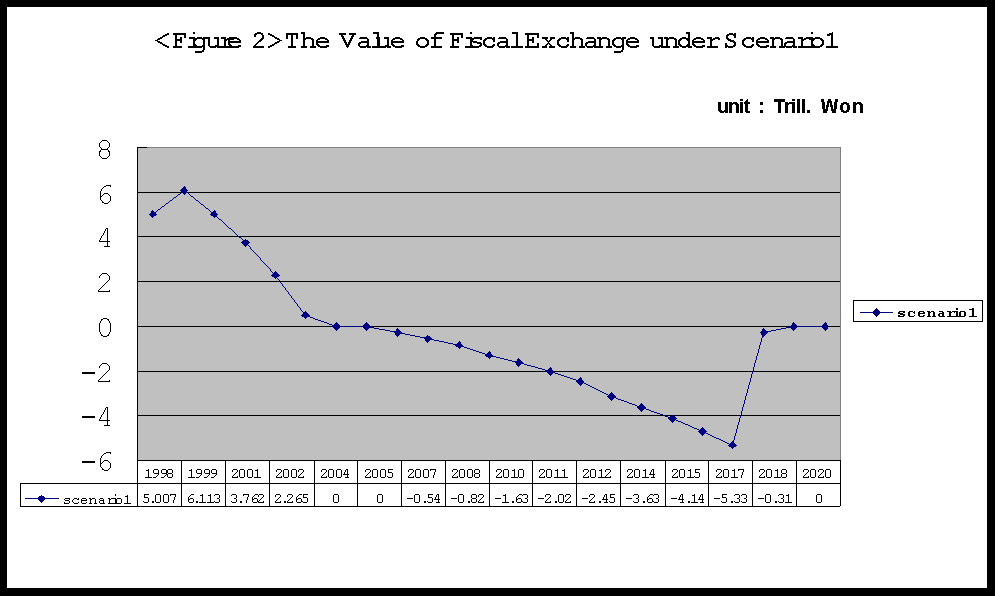
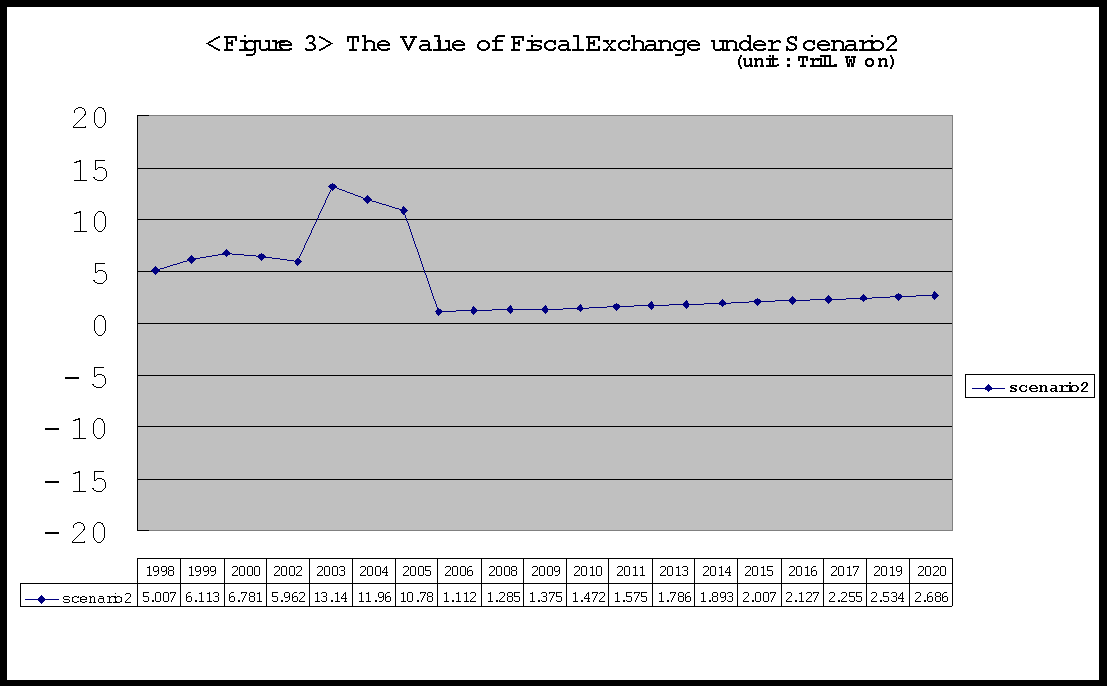
Looking into fiscal exchange under this fiscally worse situation, astonishingly the exchange is shown with positive values over whole period of debt management, which means that the net benefit could be enjoyed by tax payers, as can be seen in Figure 3.
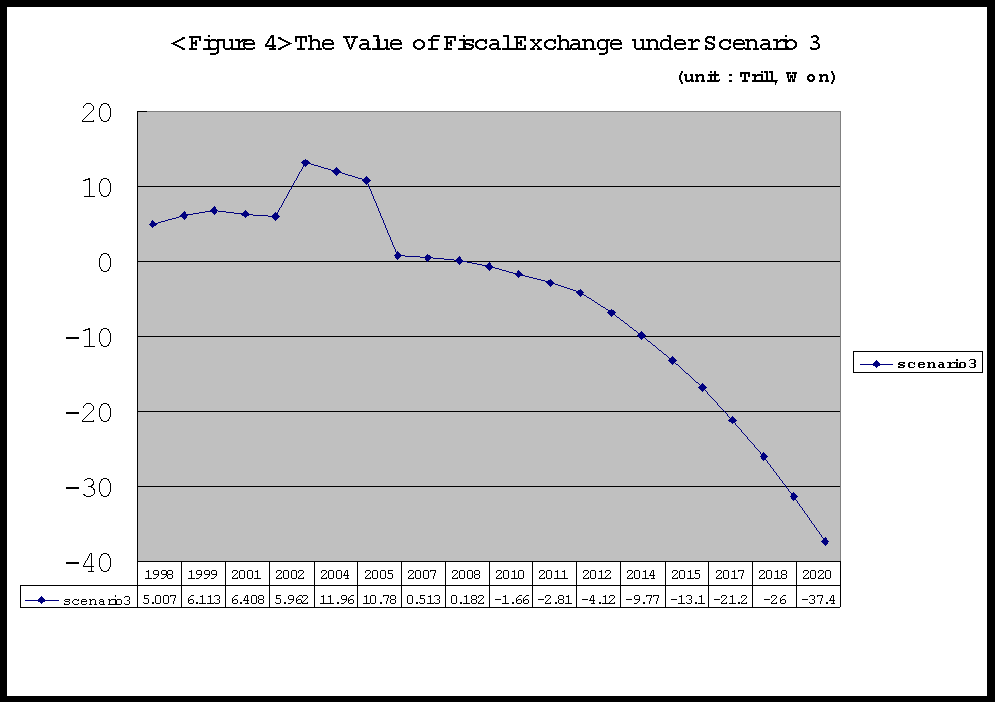
During the period of 2005-2008, the fiscal exchange between the receiving amount of expenditure by national debt and the burden cost of national debt - interest payment and refunding principal - is at last balanced thereby the thesis of Wicksell and Buchanan would be verifiable. This balance of fiscal exchange is actually possible, because there is neither the burden of interest on debt nor repayment of principal. In this respect, it should be noticed that up to the year 2006 the debt interest payment is made by the revenue arising from extra national debt issuance. Thereby, tax payers are quite free from cost of national debt at the beginning period. However, from 2006 on, the government plans to perform debt service as well as interest payment. In this case, it should be kept in mind that the principal will be refunded by the budget surplus made mainly through the expenditure restraining efforts of government. The debt interest has to be born by tax payers, that make tax burden higher. By the year 2019, the budget will be balanced by completing the debt services. The period of 2006-2019 covers the period for refunding debt services. This type of action by the fiscal authority would result in the fact that the new generation after 2020 would be forced to bear heavy tax burden for a long period. As shown in Figure 1, the total public debt balance curve will reach the peak in 2020. Since then the service will be undertaken by the fiscal authority, then around in the year 2030 the burden of debt services will be the highest level and at last in 2040 the service will be completed. It is clear that a new generation will bear whole amount of national debt, that verifies the debt theorem of Buchanan.
In this context, we shouldn
’t be surprised that if the government would fail in the management of debt service, then a tremendous debt size will eventually be made and be leading to another economic crisis with inflation and high unemployment. The whole debt crisis would continue for a long period and probably cease in the beginning of 2040’s under the condition that the government would be ready to make a hard decision with regard to the refunding of national debt balance. With this situation, we have to endure debt crisis for at least 40 years, which would give a heavy burden on our future generation.The case of scenario 3 refers to the situation in which the financial restructuring fails, which is likely to lead to the extraordinary issuance of conversion debt in future. Under this circumstance, the government would fear that the state would be bankrupted in future mainly due to the irrecoverable huge amount of national debt with frequent issues of conversion debt. So, the fiscal authority would decide to rehabilitate a sound budget operation by fiscally prudential efforts with regard to both the expenditure and the revenue side. This kind of attitude in budget operation is known as the best clue to overcome the difficulties arising from national debt4. Therefore, our scenario 3 assumes that the budget spending is constrained to the need for urgent public goods demand. This type of budget policy is considered as a fiscally prudential policy in the sense that neither the excessive expansion of expenditure nor the excessive restraining of expenditure is allowed. Its effect on debt management might be neutral. In addition, it is assumed that the fiscal authority tries to maximize the fiscal capability to mobilize the revenue source including taxes and other government revenue. This type of budget operation would be the most prudential attitude that is reliable as well as enables to get out of the awful debt state. On the whole, the scenario 3 presumes that the prudential debt management begins at the year 2000, when the issuance of national debt is to cease according to the mid-term fiscal plan. In this case, it is notable to show that the national debt balance curve would increase until the year 2015. Thereafter, it would decrease gradually and be estimated to 74.7 Trill. Won in 2020, which makes 5 % of GDP, as can be seen in Figure 5.
At last, in 2022 the national debt balance would be cleared off with zero, and a sound budget would be regenerated. It is significant in this context to notify that this would be only possible by applying a hard effort to maximize the fiscal revenue, which eventually would raise the tax burden of people. Therefore, in this scenario 3, it necessitates at least two presumptions: The first is concerned with the readiness of taxpayers to give up a part of their incomes or property for taxation and a positive compliance to the fiscal authority. The second presumption is related to a fiscal trust of tax payers to the fiscal authority. This factor is known as the most crucial force for a positive attitude of tax payers as well as not only for fiscal stability but also for sociopolitical stability, which is fundamentally related to the trust between government and tax payers. 5 In this scenario, it is also assumed that the growth rate of total fiscal revenue is 8%, whereas the current growth rate of GDP is 6%. This would apparently be paradoxical, because the fiscal burden exceeds the GDP growth rate. However, this type of fiscal situation is also possible, if the readiness of people for overcoming debt crisis and for sacrificing the present private interests is available.
Apart from the attitude of private sector, the government would provide a minimization of distortion effects on private sector primarily through the intensive application of prudent behavior in budget operation. This would not be led to a certain damage of private sector. So, our seemingly unrealistic presumption would be available in reality. If we look into the net fiscal burden by total household, up to 2008, all income classes receive the net fiscal benefits in meager amount. Tax payers are in this case benefited, though it is relatively meager to the tax burden they pay. In this context, one would mention that the government is exploited by the tax payers. As a result, the fiscal exchange seems to be unfair. Let us look into it by different income classes. Up to the year 2008, all income classes enjoy the fiscal benefits with meager amounts respectively. But, from the year 2009, all income classes are going to bear tax burden for debt services, as shown in Figure 4. This burden is also shared with fair progressivity. Though tax payers would have to bear a heavy burden of taxation, the state could be saved from heavy debt and the sound budget could be rehabilitated, as a whole , national economy would be bound to grow with stability.
It is significant to notify that this type of fiscal recovery is only possible at the cost of imposing self-constraints by private sector, namely by sacrificing the present private interests for the prosperity of state in future. As a whole, the evaluation of fiscal exchange value shows a negative value in case of scenario 1 and 3. Among them, the scenario 1 has less negative values than that of scenario3 as seen in Table7 . However, it is remarkable that the scenario 2 shows the positive value thoroughly up to 2020, which is likely to lead to generate fiscal illusion. Because after 2020, when the huge amount of state debt might be felt intolerable with its negative macro effects, then at last the movement to retire the state debt will take place and its burden will be bore by the future generation for a long time to come in future more or less up to 2040.
<Table 7 > The Value of Fiscal Exchange for Whole Period(2020) (Unit: Trill. Won)
| Fiscal Benefit(a) | Fiscal Burden(b) | Value of Fiscal Exchange (a-b) | |
| Scenario 1 | 7.1357 | 30.3727 | - 23.2369 |
| Scenario 2 | 41.3585 | 0.0000 | 41.3585 |
| Scenario 3 | 15.4714 | 69.3257 | - 53.8543 |
1. Scenario 1
Now it is the stage to look into the net burden of tax payers by income classes. In case of the scenario 1, up to the year 2002, all five-income classes receive rather the net fiscal benefit in terms of fiscal exchange. These benefits are proportionally dispersed with five different income levels, as seen in Figure 5. The poorest income class receives 1.6 Trillion Won, whereas the highest income class, the 5th quintile receives only 0.9 Trillion Won in the same year. This should be so, because the expenditure by national debt is planned to be spent for the unemployed of lower class as well as for the strengthening the tie of socio-political security that would care mostly for the low income classes. In this period, the net fiscal burden of tax payers are shared by each income classes.
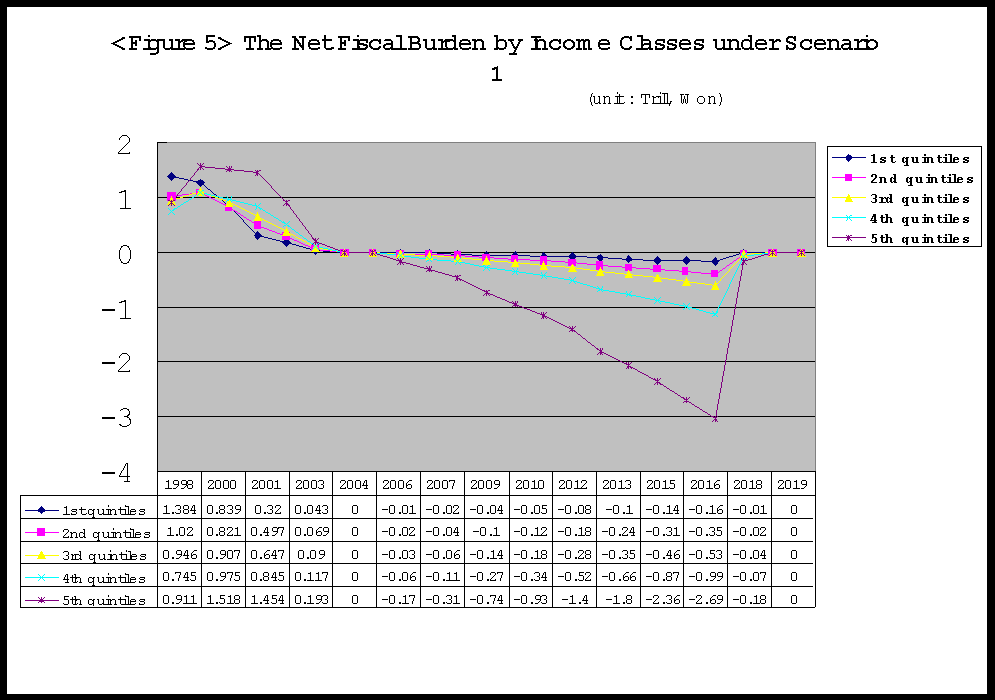
In the year 2017, however, the highest income class (5th) bears the most big amount of burden that makes 3.0 Trillion Won, whereas the lowest income class bears 0.18 Trillion Won that is approximately thirty times less than the highest income class bears, as shown in Figure 5. The pattern of net burden over income classes would result in a positive effect on in come redistribution that induces to redistribute income from the well to do to the poor people. In sum, the fiscal exchange between tax payers and the government is balanced in 2019 and 2020.
2. Scenario 2
Now we have to interpret how taxpayers would share with fiscal benefit or burden. As shown in Figure 6, during debt management period from 1998 to 2020, whole income classes would enjoy the net fiscal benefits. For 8 years from 1998 to 2006 all income classes receive relatively high levels of fiscal benefits, whereas from 2002 to 2006 it shows a remarkable increase in benefit level. Specifically, the distribution of benefits among income classes during this period seems to be regressive. However, in the subsequent period until 2020, the level of fiscal benefits is much decreased to a great extent about 1 Trillion Won for the 1st quintiles (income class) in 2020.
Its dispersion shows a distributional progressivity among income classes. The reason why the high level of net fiscal benefit during early period is realized is that the fiscal subsidies to unemployed, the private beneficiaries from financial restructuring, and the disburden against the interest payment for debt would work in favor of increasing private benefits. A sudden decreasing trend in fiscal benefit from 2006 is due to the abandonment of subsidies to unemployed as well as the financial restructuring policy are ceased to execute.
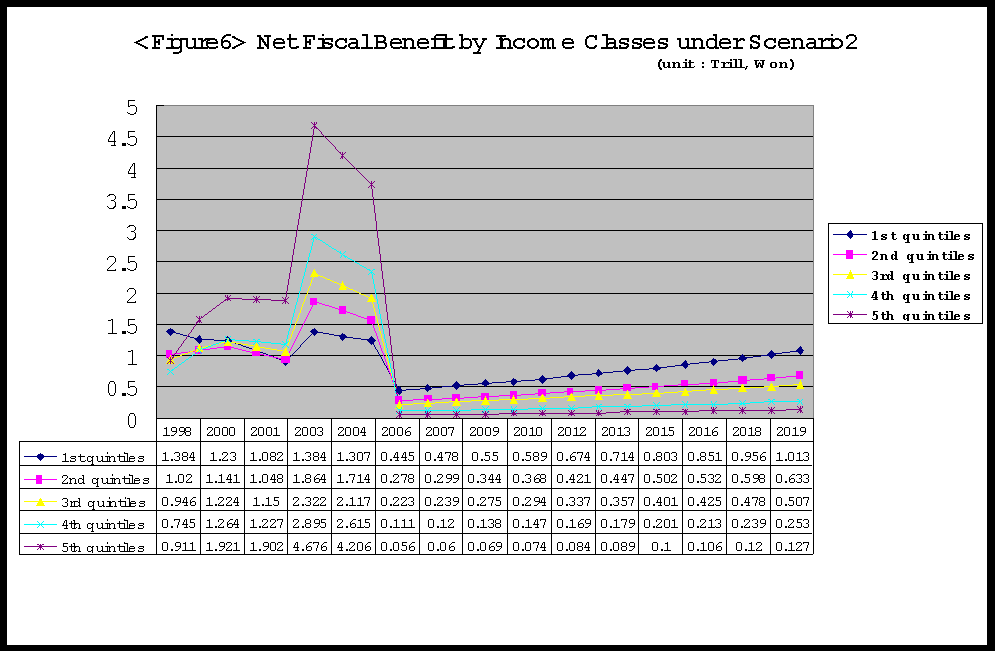
Thereafter, then, from the year 2004, the fiscal net benefits to all income classes altogether show a tendency of increasing up to the year 2020 in a proportional way. It seems to be rather paradoxical to have such a fiscal net benefits under the worst fiscal situation.6 This was already in the above explained mainly by indicating to the conversion debt issue as well as the interest payment financed by extra issuance of national debt, which would result in the disburden of taxpayers and the realization of net fiscal benefits to taxpayers as well. It is clear, however, that this type of debt management most probably would be led to the generation of fiscal illusion.7
3. Scenario 3
Let
’s have a look at the net fiscal burden by income classes in this case of scenario 3. In the early period up to 2006 as seen in the above. all income classes would enjoy net fiscal benefits. However, during the period from 2007 to 2020 all income classes would have to bear a heavy tax burden, which may lead to the GDP/Tax ratio about 24%. The distribution of tax burden among income classes seems to be variable with income class. The fifth income class bears the heaviest tax burden with the highest marginal tax rate, 40% which is progressive. However, the 3rd and 4th level of income class seem to bear with proportional to their income level. The lowest 2nd class, with striking remark, shows the considerable progressivity.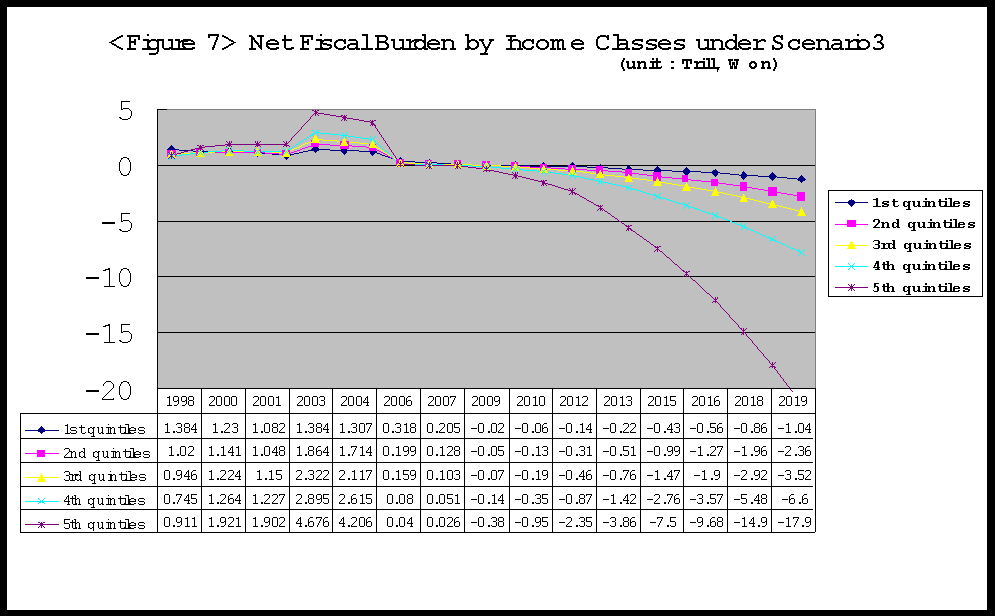
VI. Conclusion
On the basis of our analysis, we come to conclude as follows:
First of all, as to the value of fiscal exchange between tax payers and fiscal authority with regard to national debt issue seen for the whole period of debt management, we find that the scenario 3 appears to have positive values to tax payers, whereas the scenario 1 and 2 show the negative value in fiscal exchange. The scenario shows the heaviest burden on tax payers, which will contribute to the retirement of national debt. So, without doubt, it can be stated that in case of fiscally prudent situation, tax payers are in negative fiscal exchange, in which tax burden exceeds the benefits of national debt issue. Under the scenario 2, tax payers are enforced to indulge themselves into the state of fiscal illusion. It is evident the other two scenarios would impose the cost of recovering debt cricis on tax payers.
Second, in this study, we have dealt with only urban wage households, which consequently excludes rural households as well as high income classes like businessmen and the Chaebul groups. However, it would seem to be of a great significance in the sense that the urban wage households used to contribute to the tax revenue of government by 56% to 60%. Especially recognizing almost two third of tax burden for debt services would be undertaken solely by this urban households, one has to reconsider the present budget and tax system as a whole from distributional view point.
Third, with regard to the relative burden of debt services among income classes, it is seen as more or less progressive in all three scenarios. Above all, it should be mentioned in this respect that the middle income class (average annual income of 40 million Won to 60 million Won ) would bear the highest burden. Accordingly, the government should pay in policy execution a special attention to the preferences of the middle class in Korea.
Fourth, the scenario 2 that refers to the debt management policy would be most likely to lead to the generation of fiscal illusion. In the early period of debt management until 2005, tax payers would feel convenient to the fiscal authority because of no debt burden at all. Even, the fiscal authority is going not to impose the debt interest burden on tax payers, in order to guarantee a successful achievement in overcoming crisis without the additional fiscal burden on the people. However, the interest on debt is designed to be financed by the additional issue of national debt, which would be added to the tax burden of future generation.
In the scenarios 1 and 2, fiscal illusion is more deliberately generated through the issuance of conversion debt, in which tax payers are placed not to bear any extra tax burden due to debt. But in the future, for instance in 2020, the present young generation with the age of 20 will bear a heavy tax burden for debt services, whereas the current old generation with the age of 40 or older will be free from debt services in future. This fact would verify the thesis of future generation burden argued by J. Buchanan.
Notes
1
K. Wicksell, Finanzwiesenschaflieche Untersuchungen, Jena, 1896. S. 87-1012
J.M, Buchanan , "Fiscal Theory and Political Economy," Selected Essays, Chapel Hill: The University of North Carolina Press, 1962).3
J.M.Buchanan, Barro on the Ricardian Equivalance Theorem, J. P. E., vol 84, 1976.4
K.Mackscheidt und U.Beland, Die Tilgung oeffentlicher Schulden, Koeln, 1998, S. 168.5
G. Schmoelders, Finanzpolitik, Berlin, 1965, 5.321.-3266
D.Bell and L, Thurow, The Deficits : How Big? How Long? How Dangerous? , NYU Press, 1985.7
J.M.Buchanan, and R. Wagner, Democracy in Deficit, Academic Press, 1977.
References
Korea. IMF Fiscal Affairs Dept. Sept, 3, 1998.
Summary of the Mid-Term Fiscal Plan 1999-2002, January 1999.